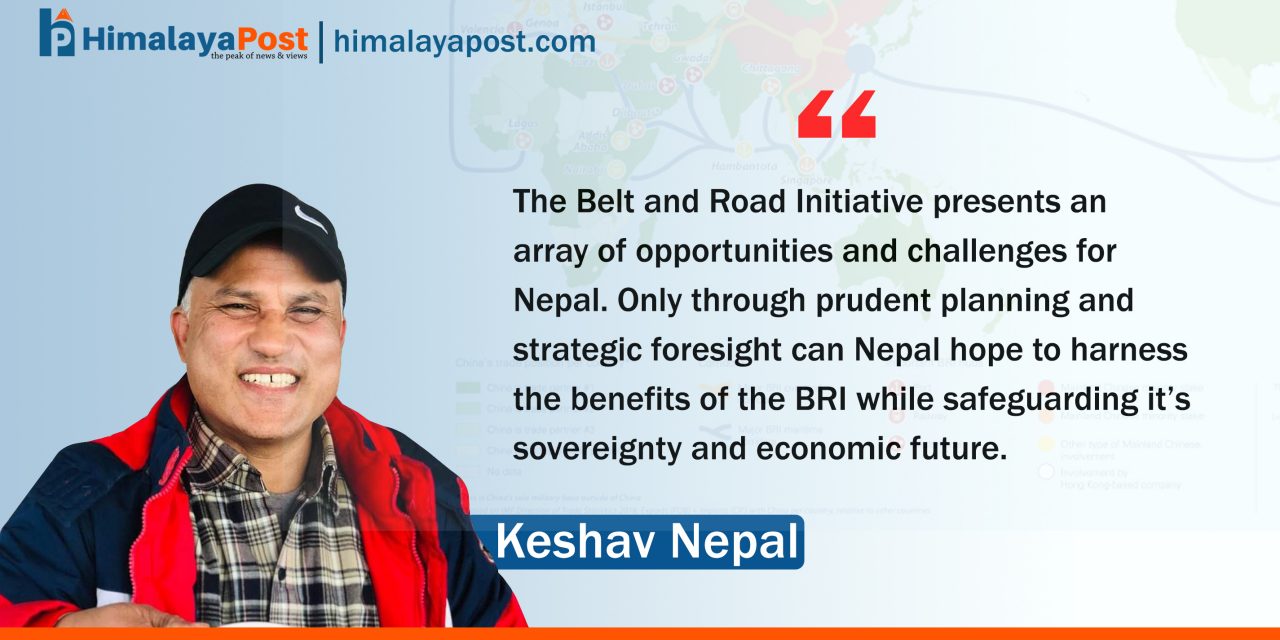-Keshav Nepal
Kathmandu- As Prime Minister KP Sharma Oli’s upcoming trip to China, the Belt and Road Initiative (BRI) looms large on the agenda. China is championing this ambitious global development strategy that promises significant benefits for developing nations through enhanced infrastructure and connectivity. Nepal, a country with natural beauty and cultural heritage, but facing economic challenges, the BRI could be instrumental in driving growth and modernization. While examining this potential future, we need to be cautious as the BRI has inherent risks that could put Nepal’s economy, sovereignty, and stability in jeopardy.
Nepal should be alert on Allure of Infrastructure Development and Connectivity
At first glance, it’s undeniable how appealing it is to improve roads, railways, and energy projects. Enhanced infrastructure could lead to greater trade opportunities, job creation, and overall economic growth. But history serves as a cautionary tale. Due to BRI investments, Sri Lanka’s experience with a crippling debt crisis highlights the precariousness of these loans. The Hambantota Port, once a symbol of hope, was leased to a Chinese company for 99 years after the country failed to repay its debts. Nepal must heed these lessons diligently, as it lacks the robust revenue mechanisms to manage significant foreign debts.
Perils of Over–Reliance on a Single Partner
An over-reliance on Chinese funding raises serious concerns over national autonomy. Nepal is in danger of losing its negotiating power and political independence while engaging with China for crucial infrastructural projects. The implications of this dependency could be profound, especially concerning sensitive projects near the Indian border. Pakistan and Sri Lanka have witnessed how Chinese investments have turned into political leverage, potentially endangering their sovereignty. For Nepal, maintaining a balanced geopolitical stance is essential in an already complex regional landscape.
Economic Imbalance: A Looming Threat
A widening trade deficit is a possibility due to China being the dominant exporter to Nepal. Enhanced connectivity could facilitate an influx of Chinese goods into the Nepali market, sidelining local industries and exacerbating economic imbalances. This could cause great harm to a nation that relies heavily on agriculture and small-scale industries for its economy. The influx of cheaper imports could stifle local production, undermining self-sufficiency and economic resilience.
What about Environmental and Social Ramifications ?
It is essential to note that, the environmental implications of large-scale BRI projects cannot be overstated. As a mountainous nation, Nepal is particularly vulnerable to landslides, earthquakes, and floods. The Rasuwagadhi Hydroelectric Project and other infrastructure projects have already raised concerns about environmental degradation and social displacement. Unchecked development risks not only the physical landscape but also the social fabric of communities that depend on these ecosystems for their livelihoods.
Geopolitical Strains: A Delicate Balance
Engagement with the BRI has the potential to sour Nepal’s historically delicate relationship with India. As a strategic rival to China, India views Nepal’s alignment with the BRI with apprehension. The Lipulekh road dispute serves as a stark reminder of the sensitivities surrounding border infrastructure. Any perceived encroachment by China could lead to escalated tensions, compromising Nepal’s diplomatic standing and economic access to Indian markets.
Necessity of Transparency and Accountability
The lack of transparency in BRI projects causes significant governance concerns. The opaque nature of Chinese loans and project management can lead to corruption and misallocation of resources. Nepal, with its limited institutional capacity, must establish stringent oversight mechanisms to ensure that projects are executed transparently and effectively. Lack of accountability could make the promise of development a breeding ground for corruption.
The Specter of Debt-Trap Diplomacy
Discussions about the BRI are heavily focused on the concept of ‘debt-trap diplomacy’. While some may debate the validity of this notion, the potential for Nepal to be ensnared in unmanageable debt exists. Should the nation struggle to repay Chinese loans, it could be coerced into ceding control of key infrastructure or compromising its foreign policy stances. This prospect poses a serious threat to national sovereignty and economic stability.
A Call for Caution and Strategic Planning
The Belt and Road Initiative presents Nepal with a variety of opportunities and challenges. While infrastructure development may seem appealing, it’s important to consider the dangers of unsustainable debt, economic dependency, environmental degradation, and geopolitical tensions. To navigate this double-edged sword, Nepal must prioritize transparency, engage in careful evaluation of project viability, and maintain balanced relations with both China and India. Only through prudent planning and strategic foresight can Nepal hope to harness the benefits of the BRI while safeguarding its sovereignty and economic future.
.





